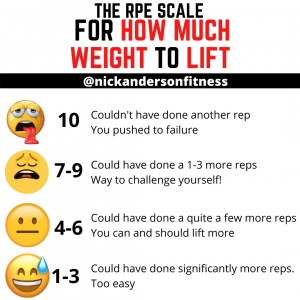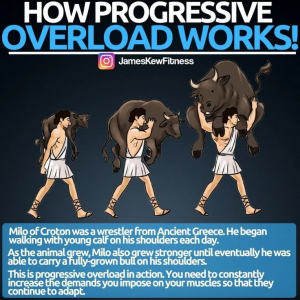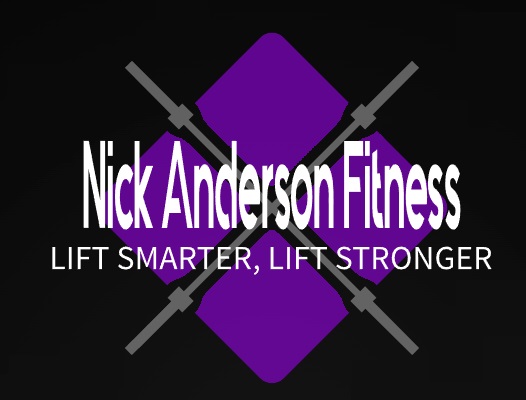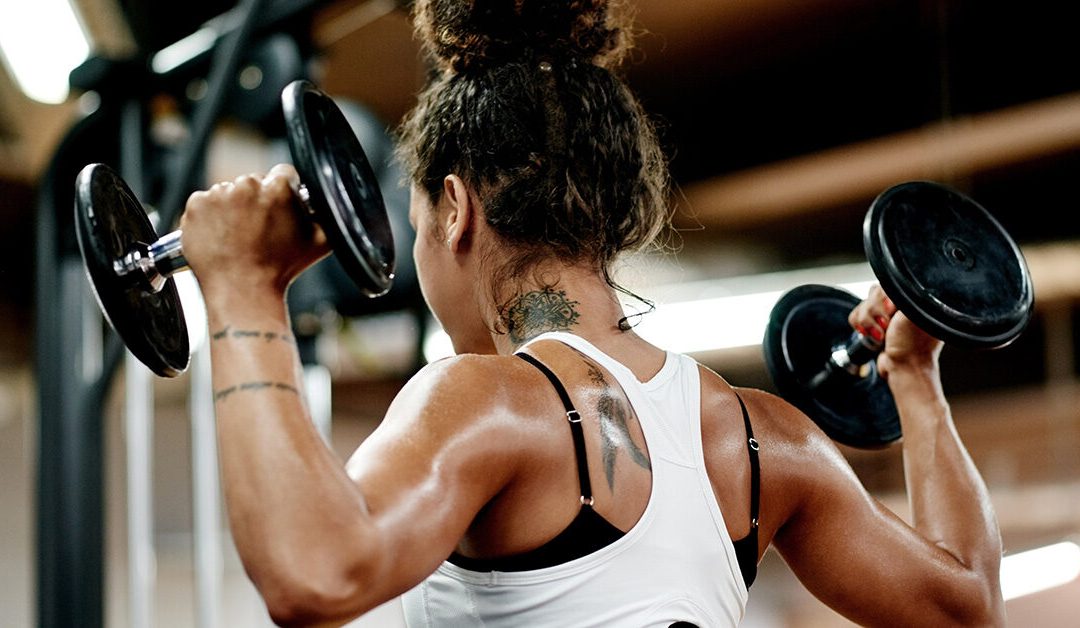Walk into the gym and one of the first things you’ll see is a big rack of dumbbells that range from size tiny to massive.
You look at your workout program (that you should absolutely have, and if you don’t here’s a free one) and the first exercise is a dumbbell bench press.
You may think to yourself, okay cool dumbbell bench press. But which weight should I pick up?
You don’t want to pick up a weight that’s too light, because then what’s the point? You could just go home and lift a couple of sticks of butter instead.
And you don’t want to pick up a weight too heavy, because then you’re going to drop it on your face, be embarrassed, and also injured. And then you’re going to have to tell the paramedic that you didn’t read an article on how much weight you should be lifting, which is also embarrassing.
By the end of this article, you’ll have the confidence to know how much weight you should lift for the first time you try an exercise.
You’ll also know how and when to increase weight.
You’ll know which exercises you’ll be able to choose a heavier weight for, and ones you may need to choose a lighter weight for, and get the maximum benefit out of it.
You have just one job in this.
Read every single word of this article.
Don’t skip, don’t skim, because then you’ll miss some crucial information.
Deal?
Goodie.
Let’s go.
How Much Weight Should You Be Lifting?
Something to consider before you even touch a weight
Before you head straight for the dumbbell or squat rack, there’s something you need to do first.
You want to make sure you can execute a movement appropriately before you add weight to the movement.
Imagine not being able to do a bodyweight squat with proper form, and then you try and add weight to it.
You don’t really have to imagine, you’ll see this at the gym all the time.
You’ll frequently see people doing a squat with 300+ pounds on their back and their form looks more like a manatee having a seizure than an actual squat.
It doesn’t improve your squat strength (though it may improve your seizing manatee impression you’ve been working on for your next charades party).
What it does do is improve your risk for injury.
So before you attempt a squat with weight, master the bodyweight squat first.
Before you attempt a deadlift with weight, try it with a broomstick first.
Do this for any movement you are unfamiliar or unsure about.
And then video yourself doing it, and analyze your own technique.
This is something I do all the time with my online coaching clients, so together we can review technique and ensure the movements are both safe and effective.
And by the way,
This isn’t something just for beginner lifters.
This is something I to this day do.
If I feel like my movement is off with weight, I’ll go back and do it without, and analyze my technique.
Being an intermediate/advanced lifter doesn’t mean you shouldn’t go back to fundamentals and just practice movement patterns.
You absolutely should.
How Much Weight Should You Be Lifting?
Alright, so you’ve mastered the movements.
You’re deadlifting properly with the broomstick, so now you can put the Nimbus 2000 back in the broom cupboard.
And you’ve mastered the bodyweight squat so now you can get on and off the toilet with perfect form. That’s good. That will come in handy later in life.
So now it’s time to pick up some weights.
But, how much weight should you be lifting?
There’s a few things we are going to cover in the coming sections to give you a solid understand how heavy of a weight you should be lifting.
The RPE Scale

Above is an image of the RPE Scale.
RPE stands for Rate Of Perceived Exertion
Which basically is a scale of how hard something felt.
A 1 on the RPE scale feels as hard as buttering and eating your morning toast.
While a 10 on the RPE scale feels as hard as your morning toast buttering and eating you.
But seriously, a 10 should be HARD.
You should not be able to get out a single more rep at RPE 10.
And your face should look like this.

Yeah, it should look like you’re about to shit yourself (don’t actually shit yourself).
The RIR Scale
And going hand in hand with the RPE scale, is the RIR scale.
RIR stands for reps in reserve.
Which means how many reps you could have done in addition to the ones you actually did.
For example, let’s take that dumbbell bench press we were going to start your workout with in the beginning of the article.
You walk in, you grab a pair of 20 pound dumbbells off the rack.
You do a set of 10, but if some dude puts a gun to your head and told you to do more, you could have got 6 more (that dude really wanted you to push hard).
This means you had 6 reps in reserve.
This works in reverse with the RPE scale. So 6 reps in reserve means you were at RPE 4.
If you had 1 rep in reserve, you would have been at RPE 9.
One thing to note about the RPE/RIR scales. It’s unfortunately, not a perfect system. And it’s left up to a lot of ambiguity, and self speculation.
So you can finish a set and think it was really hard. But in reality, you could have busted out another 5-7 reps.
Not sure what RPE you’re working at?
Test it.
This is a method I’ve used with my in-person clients.
I was recently training one of my favorite clients, Katie, and she was doing a seated shoulder press. I asked her, on a scale of 1-10 how hard did that feel? She told me with the highest level of confidence that it was a solid 9.
So I said, “Cool, alright on the next set I want you to do an extra 10 reps just for fun”.
She did them, all 10 extra reps.
And I said “Katie, that was not a 9.”
Begrudgingly, she asked me for a heavier weight.
This is something you can test on yourself, if you think you’re at RPE 9, try adding a few reps. When you legitimately fail a rep, that’s where it becomes RPE 10/RIR 0. Because you had no reps in reserve, you failed the rep.
Note on training to failure:
This is something that is okay and even beneficial to do from time to time, however be careful.
Choose your movements wisely here. Training to failure on exercises where there is a danger of dropping a weight on you, or getting stuck under a barbell is not worth the risk without a spotter. I’d rather you have a slightly less optimal training than die in a freak bench press accident.
Training a pushup to failure on the other hand. What’s the risk of injury? You just go back to the floor.
Think about this when training to failure and choose your movements wisely.
When the risk is there, find a spotter.
What RPE should you be working at?
With my online coaching clients, I generally want them working at about RPE 7-9.
So this means when you’re choosing a weight, you should choose one where you if you’re doing a set of 10, you could probably only do about 1-3 reps more.
So how do you tell?
Trial and error.
Try a weight, see how it feels. If it feels too light for your set, increase.
The nice thing is, you have plenty of time in your training career to find the right weight for you.
Just make sure, above all else, you are still lifting with good form.
When Should You Increase In Weights?
So you’ve busted out that set of 10 reps of dumbbell bench press at 20lbs. And it felt challenging. It was a solid RPE 9, and your form was on point. Great. You’re crushing it.
But guess what.
It won’t be challenging forever.
Because the fun part about strength training is, that it gets you stronger.
As you continue to lift the same weight, your body starts to adapt to that.
This happens through a principle known as progressive overload.
What the hell is that?
Glad you asked.
Progressive Overload

Progressive overload is when you increase the demands of your training to increase the output of your body.
This can be achieved through lifting a heavier weight, increasing reps, increasing sets, or increasing the time under tension for your lifts.
By doing this, your body will begin to adapt to that demand by getting stronger, and increasing muscle size.
So using the 20lb bench press example, as that occurs, your body begins to adapt to lifting 20lb dumbbells.
Until it becomes easy.
So if you keep lifting those 20lb dumbbells for the rest of your life at the same reps and same sets, your body will not continue to change, because you’re not putting any new demands on it.
So when RPE 9 does not feel like RPE 9 anymore, it’s time to give the next weight up a shot. This could mean getting a 5lb heavier dumbbell, or putting a pair of 2.5lb plates on to the end of your barbell. It could also mean doing additional reps at the same weight. But, at a certain point, you’re definitely going to want to increase the weight, and that should generally be your first choice.
How quickly does progressive overload happen?
This can vary depending on whether you’re a beginner or intermediate lifter.
If for 0-12 months you’ve been following a well structured program (sorry, Beachbody and YouTube workouts don’t count), you are considered a beginner lifter.
If you’ve been training intelligently for 12+ months, you’re an intermediate lifter.
If you’re an advanced lifter, carry on. You probably don’t need this article.
For the beginner lifter,
It’s quite common to see very fast strength progression within that first 12 months.
You have probably heard this referred to as “newbie gains”, and it’s very real.
So you may walk into the gym day 1, bench press 20lb dumbbells, and then next week be able to do 25, and then 30s the following week.
Your progress will be very quick.
So enjoy this while it lasts.
If you’re an intermediate lifter, your newbie gains are done.
But that doesn’t mean you won’t be able to lift heavier, and continue to make gains.
It just might be a little slower.
It’s not uncommon to not be able to increase in weight for an entire month, or even longer.
Tracking Weights
When you step into the gym on any given day, you should know what you lifted last time.
That way you’ll know to either attempt that weight again, or go up in weight.
So by keeping a log of what you lift, you’ll have an idea of when it might be time to try and increase.
You don’t have to be crazy detailed (though you can if you want to be).
If you look at your log and see that 9 months ago you were lifting the same exact weight, and you’re wondering why you haven’t seen a lot of changes… you know why.
Should You Lift The Same Amount Of Weight For Each Exercise?
If you walk into the gym and are now able to hit 30 lb dumbbells for the bench press, should you be able to do the same for a lateral raise, or a dumbbell curl?
I think Bishop Bullwinkle can answer that for you.
Not every exercise is the same. With each exercise, you are working different muscles, and creating different lever arms.
And different muscles are stronger than others.
For example, your legs are stronger than your back.
(Lift with your legs not your back)
And your legs are a hell of a lot stronger than your shoulders.
That’s why people can do squats and deadlifts with absolutely insane amounts of weight, but can’t do bicep curls with the same weight.
In general, the smaller the muscle being worked, the lighter the weight you’ll need to lift.
Of course, with each exercise, this will be a trial and error to figure out which is right for you.
But if you’re not lifting the same for a curl as you are a bench press, don’t worry. That’s normal. And if you are lifting the same amount for a curl as a bench press, you need to increase the weight of your bench press. It’s too light.
Keep using the RPE/RIR scale to figure out what’s right for you for each exercise.
Final Thought
So now, you can take a nice deep breath.
Because you have an idea of how to attack the weights next time you step into the gym.
You know that through trial and error, you can find out how to get to an RPE 7-9.
And you know that you won’t stay there forever, and eventually, you’ll have to increase weight. And if you’re a beginner lifter, that time will be very soon.
Now, you’re ready to make progress, and go crush your goals.
If you have any questions, e-mail me, and I’d love to chat about it – nick@nickandersonfitness.
Or you can always DM me on Instagram.
I’m always happy to answer any questions you may have.
Much Love,
Nick

